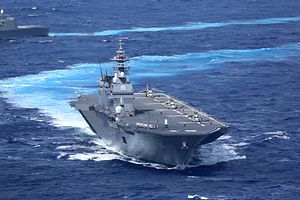The Japan Maritime Self Defense Force (JMSDF) and the U.S. Navy concluded a passing exercise (PASSEX) in the South China Sea this week, according to a May 18 U.S. Navy press release. The principal purpose behind a passing exercise is to ensure that allied navies are able to communicate and cooperate in the event of a conflict or humanitarian relief operations.
“The PASSEX included personnel exchanges, cross-deck flight operations, communications exercises, division tactics, a tracking exercise and photo exercise,” the statement reads. “The bilateral event aimed to enhance interoperability between the two navies and emphasized the importance of communications and coordination while operating together at sea.”
On the JMSDF side participants included the helicopter carrier JS Izumo, the lead ship of the Izumo-class, and the guided-missile and antisubmarine warfare (ASW) Takanami-class destroyer JS Sazanami. The U.S. Navy dispatched the Independence-class Littoral Combat Ship (LCS) USS Coronado, which deployed to the Asia-Pacific and the U.S. Navy’s 7th Fleet area of operations in October 2016.
All three ships participated in the International Maritime Defense Exhibition (IMDEX) in Singapore earlier in the month.
During the naval drill both navies conducted personnel exchanges employing MH-60S and SH-60K Seahawk helicopter stationed aboard the USS Coronado and JS Izumo. “The three ships conducted precision maneuvering events and communication exercises while underway, both focused on ensuring the two navies are prepared to work together efficiently in future operations,” the statement continues.
“This PASSEX allowed the Coronado crew to operate and train side-by-side with professional sailors from one of the world’s most capable naval forces,” said the commanding officer of the LCS. “Our ships executed flawlessly while operating in close proximity, and that’s a testament to not only the expertise of the U.S. and JMSDF sailors, but also to the strength of our naval partnership.”
The Independence-class variant of the LCS features a larger flight deck and has more fuel capacity in comparison to the Freedom-class LCS. The USS Coronado is also the first LCS to be armed with an advanced anti-ship missile system, the so-called Advanced Harpoon Weapon Control System (AHWCS) capable of firing RGM-84D Harpoon Block 1C missiles.
“My ship, JS Izumo, the largest ship in the JMSDF, has high capability in support of HA/DR (humanitarian assistance/disaster relief) activities in this region,” said Captain Yoshihiro Kai, the commanding officer of the JS Izumo. “This bilateral exercise improved our teamwork, tactical skill and readiness.”
The Japanese Navy officially classifies the Izumo-class as helicopter destroyers in order to downplay the warship’s offensive capabilities. “The ship is designed to accommodate up to 14 helicopters (seven Mitsubishi-built SH-60k ASW helicopters and seven Agusta Westland MCM-101 mine countermeasure helicopters), five of which can simultaneously take off and land, given the Izumo’s large flight deck and five landing spots,” I explained previously.

































